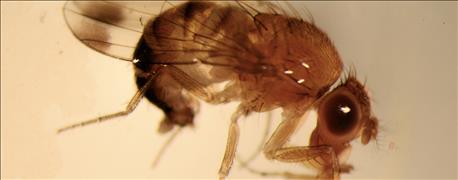July 6, 2016

The tiny spotted-wing drosophila fruit fly has already been found in very low numbers in the Mid-Atlantic and Northeast, reports Kathy Demchak, Penn State University Extension entomologist. So it’s time to be watching for their presence in raspberries, blueberries and other thin-skinned fruit.
A few Pennsylvania growers have reported finding larvae in late-season strawberries. Though it’s possible the larvae were SWD, in other cases in the past, larvae found in late-season strawberries have proven not to be SWD in Pennsylvania.
Instead, they were offspring of other types of fruit flies or sap beetles. Being typical “maggots”, the headless larvae look identical.

CREEPY, COSTLY BUG: This is a magnified image of the spotted-winged drosophila. The adult is easily identifiable. The fruit-spoiling larvae isn’t.
Sap beetle larvae are larger and have heads, notes Demchak. If other fruit flies or sap beetles were the problem, there would be some sign of berry damage or softening from a disease or moisture, or tiny holes in the fruit.
If the fruit has just turned ripe and was completely intact except for damage from the ovipositor, the likelihood of SWD larvae is much higher, she adds. The only way to tell for sure is to take a fruit sample of the fruit, and allow the adults to hatch out.
Here’s how: Placing the fruit on an absorbent layer such as sand or paper towels in an airtight container so the flies can’t escape. The sand or paper towels absorb the decomposing fruit’s moisture that would otherwise drown the insects. After a week or so, the adults hatch out. The container and contents can be frozen to keep the adults from flying away when you open it.
New lures and remedies
Research trials in New York and Ontario found a new lure by Scentry to be more specific and capture SWD adults earlier than other baits. Check out a summary of work at Cornell's spotted wing drosophila blog. Also check out Penn State Extension's spotted wing drosophila information series.
A number of good fact sheets and web sites are also available to help with identification and control. A 2015 factsheet that discusses monitoring methods and pesticides is available online from the University of Maryland.
You May Also Like




